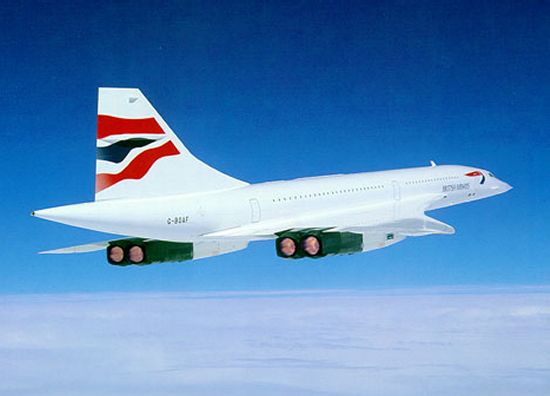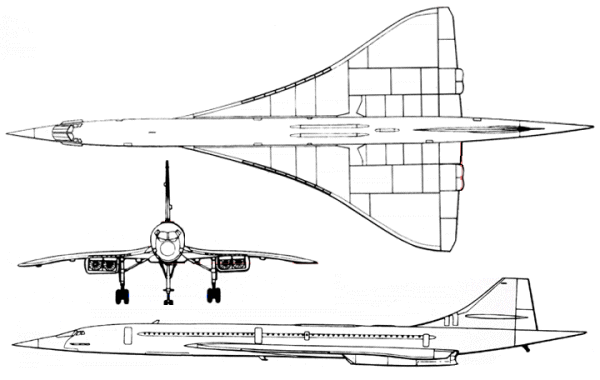|
||||||||||
|
|
||||||||||
|
||||||||||
|
|
||||||||||
 - -
 - -
|
|

|
Aerospatiale/ British Aerospace Concorde Long-Range Jetliner |
|
DESCRIPTION:
One of only two supersonic airliners ever to enter service, along with the troubled Tu-144, the legendary Concorde was intended to usher in a new era of high-speed commercial travel. The aircraft can trace its history to the late 1950s when both Sud-Aviation (later merged into Aerospatiale) in France and Bristol Aircraft (later part of British Aerospace) were studying the possibility of a practical commercial supersonic design. Because of the many complex technological hurdles to be overcome in such an aircraft, both companies soon realized that the development costs could not be covered by either firm on its own. As a result, the two companies agreed on a joint program in 1962, with development costs largely funded by the British and French governments. The original specifications called for a cruise speed between Mach 2.5 and 3, but cooling and materials issues forced a reduction to around Mach 2. The resulting Concorde was largely a point design heavily optimized for flight at its cruise condition. The fuselage was very long and slender, taking the area rule into account, and the wing was of a modified delta design called an ogival wing for maximum efficiency in supersonic flight. At low speeds during takeoff and landing, the wing required a high angle of attack to maintain lift, but at the expense of very limited visibility for the pilots. This problem was rectified to some degree by "drooping" the entire nose section during these phases of flight. The Concorde also dispensed with horizontal tail surfaces, instead using a series of elevons across the wing trailing edge for pitch and roll control. Although many airlines were eager for supersonic aircraft from the mid 1960s until the early 1970s, rising oil prices, concern about sonic booms, and complaints about the aircraft's noisy engines doomed the Concorde to poor sales. Of the 70 aircraft originally ordered and 300 planned, only 16 production models were actually built. These aircraft were so costly that no airline was willing to purchase them, so the French and British governments essentially gave them away. Seven each were placed in service with Air France and British Airways. These aircraft were most often flown on regularly scheduled services between London or Paris and New York, but flights to Washington DC, Dallas, Mexico City, Rio de Janiero, Caracas, and Singapore were also frequent until the early 1980s. Additional charter flights to the Carribbean and South America were also commonly flown. Though costly to operate, the Concorde posted an excellent safety record until July 2000 when an Air France Concorde suffered a fatal crash near Paris. The subsequent investigation concluded that the plane's tires burst after running over a piece of metal debris on the runway. These tire fragments impacted the engines and wing fuel tanks causing a fatal fire and loss of power. Nine of the seven British and five French aircraft remaining in service were modified with new landing gear, fuel tank protection, and structural improvements ordered by aviation authorities. The extensive testing and recertification process that followed prevented the Concorde from resuming commercial flights until September 2001. Unfortunately, weak demand in the wake of the September 11 terrorist attacks and rising maintenance costs for the aging planes forced both airlines to retire the Concorde fleet. The final Air France flight occurred on 31 May 2003, and British Airways ceased Concorde operations in October 2003. British Aerospace had hoped to maintain one flyable Concorde for use during airshows or other special occasions, but plans were scrapped due to financial and logistics issues. All remaining British and French aircraft have been donated to museums across Europe and North America. At the present time, it does not appear that any supersonic replacement is likely to be available until at least 2020, if ever.
Last modified 27 September 2009
|
|
| HISTORY: | |
| First Flight | 2 March 1969 |
| Service Entry | 21 January 1976 (with Air France and British Airways) |
|
Retirement
|
24 October 2003
|
| CREW: |
three flight crew: pilot, co-pilot, flight engineer up to six flight attendants |
| PASSENGERS: |
(typical) 100-128 (maximum) 144 |
|
ESTIMATED COST:
|
£23 million or $46 million (1977$)
|
| AIRFOIL SECTIONS: | |
| Wing Root | unknown 3% thick |
|
Wing Tip
|
unknown 2.15% thick
|
| DIMENSIONS: | |
| Length | 203.75 ft (62.10 m) |
| Wingspan | 83.83 ft (25.56 m) |
| Height | 37.42 ft (11.40 m) |
| Wing Area | 3,856 ft² (358.22 m²) |
|
Canard Area
|
not applicable
|
| WEIGHTS: | |
| Empty | 173,500 lb (78,700 kg) |
| Normal Takeoff | unknown |
| Max Takeoff | 408,000 lb (185,065 kg) |
| Fuel Capacity |
internal: 210,940 lb (95,680 kg) external: not applicable |
|
Max Payload
|
29,500 lb (13,380 kg)
|
| PROPULSION: | |
| Powerplant | four Rolls-Royce/SNECMA Olympus 593 Mk 602 turbojets |
| Thrust |
152,200 lb (677.2 kN) with afterburner
|
| PERFORMANCE: | |
| Max Level Speed |
at altitude: Mach 2.23 at sea level: unknown max cruise speed: 1,355 mph (2,180 km/h) at 51,300 ft (15,635 m), Mach 2.04 typical cruise speed: Mach 2.0 |
| Initial Climb Rate | unknown |
| Service Ceiling | 60,000 ft (18,290 m) |
| Range |
max fuel: 3,560 nm (6,580 km) max payload: 3,365 nm (6,230 km) |
| g-Limits |
unknown
|
| KNOWN VARIANTS: | |
| Concorde 001 | First French prototype, retired to the Musée de l'Air et de l'Espace at Le Bourget in October 1973 |
| Concorde 002 | First British prototype, retired to the Fleet Air Arm Museum at Yeovilton in March 1976 |
| Concorde 01 | British preproduction model with a modified visor windshield, longer forward fuselage, and extended tail, retired to the Imperial War Museum at Duxford in August 1977 |
| Concorde 02 | French preproduction model, retired to the Musee Delta at Orly Airport |
| Concorde |
Production passenger model; 16 built and 14 placed into commercial service
|
| KNOWN OPERATORS: |
Air France British Airways |
|
3-VIEW SCHEMATIC:

|
|
SOURCES:
|
|


|
Aircraft | Design | Ask Us | Shop | Search |

|
|
| About Us | Contact Us | Copyright © 1997- | |||
|
|
|||